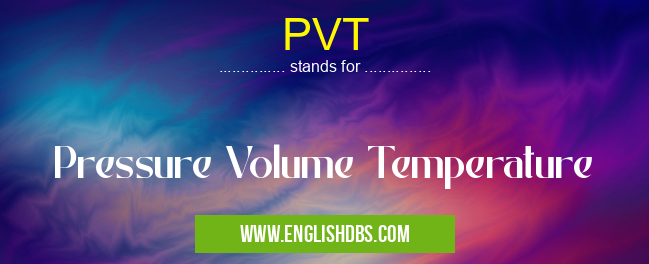What does PVT mean in UNCLASSIFIED
PVT is an acronym used to describe the interdependent properties of Pressure, Volume, and Temperature; three fundamental thermodynamic parameters which form the basis for a variety of engineering calculations. PVT is used in many industries such as oil & gas production, automotive production, mining and aerospace. In a nutshell, PVT is an acronym that represents the relationship between these three crucial thermodynamic parameters. This article will explain what PVT stands for and its importance in various fields of engineering and industry.

PVT meaning in Unclassified in Miscellaneous
PVT mostly used in an acronym Unclassified in Category Miscellaneous that means Pressure Volume Temperature
Shorthand: PVT,
Full Form: Pressure Volume Temperature
For more information of "Pressure Volume Temperature", see the section below.
Pressure-Volume-Temperature
Pressure (P) can be defined as the force applied by a surrounding medium per unit area on any object within its vicinity. Pressure has units such as kilopascals (kPa), atmospheric pressure (atm) or pounds per square inch (psi). This parameter is important when designing and manufacturing objects that must withstand external forces applied upon them during operation.
Volume (V) refers to the amount of space occupied by an object or a particular amount of matter within it; usually expressed in cubic meters (m3). Volume is an important parameter in determining the capacity of certain containers like pipelines or tanks as well as other shapes which may hold liquids or materials at different depths within them. Temperature (T) is measured in degrees Celsius (°C), Kelvin (K), Rankine(°R), Fahrenheit(°F); this parameter indicates how hot or cold something is relative to its surrounding environment.
Importance of PVT
PVT calculations are crucial for numerous operations from chemical processing plants to natural gas production businesses – where they are used to calculate fluid properties such as viscosity, solubility, diffusion coefficient, etc., based on temperature changes experienced during operations. In addition to that it also helps engineers design vessels and other equipment able to safely resist external forces without being damaged when dealing with high temperatures and pressures encountered during their use. Furthermore, understanding these relationships between pressure volume and temperature can provide insights into systems behavior under dynamic conditions. For example, automobile engines rely heavily on variables such as engine compression ratio which depends heavily on PVT values to achieve optimum performance levels.
Essential Questions and Answers on Pressure Volume Temperature in "MISCELLANEOUS»UNFILED"
What is PVT?
PVT stands for Pressure Volume Temperature. It is the combination of these three properties that describe the state of a system (e.g. a gas in a container).
What is the significance of PVT in engineering?
PVT is important in engineering, as it provides important insight into how materials and systems behave when exposed to different levels of pressure, volume and temperature conditions. This information can be used to study and design engineering systems, such as combustion engines or compression chambers.
How is PVT commonly measured?
The most common way to measure PVT properties is by using specialised instruments such as high-pressure transducers, thermocouples, and pressure gauges. These devices are able to measure changes in pressure, volume and temperature for materials under various conditions.
Is there an equation that relates all three properties together?
Yes - the general equation for relating Pressure Volume Temperature is known as the Ideal Gas Law which states the product of pressure (P) multiplied by volume (V) must equal a constant number multiplied by temperature (T). This equation can be expressed mathematically as P*V = nRT, where n stands for number of moles and R stands for universal gas constant 8.31446 J/mol K
Can phase transitions occur with changes in PVT conditions?
Yes - phase transitions are changes from one state of matter to another caused by changes in temperature, pressure or both. For example increasing volumetric flow rate through a valve or heat exchanger can cause evaporation from liquid to gas or condensation from gas to liquid. In other words phase transitions are fundamentally controlled by Pressure Volume Temperature conditions.
Does atmospheric pressure affect PVT measurements?
Atmospheric pressure will affect measurements taken at sea level since variations in this will affect results relative to other locations at different altitudes due to air density differences between sites. However, if measurements need to be corrected for these effects this should be accounted for before data analysis takes place.
How do you calculate ideal gas law constants?
The ideal gas law constants depend on two main parameters - specific heat capacity (Cp) and molar mass (M). To calculate them you need to use an equation that includes these two parameters along with the universal gas constant R (8.31446 J/mol K). Once you have determined these values you can then use them to calculate Pressure Volume Temperature relationships related to your system’s components.
Final Words:
In conclusion, PVT measurements are essential for engineers dealing with thermos-dynamic processes involving fluids or gases since it provides valuable data necessary to make informed decisions regarding operational performance safety margins etcetera. Industries ranging from oil & gas production all the way down automotive production rely heavily on accurate PVT data for successful operation hence making this concept an invaluable tool for any engineer’s arsenal.
PVT also stands for: |
|
| All stands for PVT |
